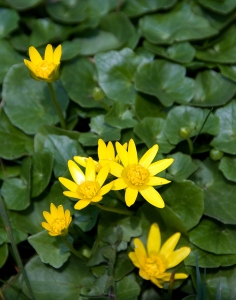[An Archaeologist’s Guide to British Species] #85: Celandine, Lesser
In 2024, I am continuing to blog an A-Z compendium of human interactions with species in the British landscape. A list of references for information used in this series can be found here. An index of species covered so far can be found here.
Celadine, Lesser

Lesser celandine flowers, by Michal Osmenda from Brussels, Belgium – https://www.flickr.com/photos/michalo/2425723494/ (CC BY-SA 2.0)
Ficaria verna Huds. (formerly Ranunculus ficaria L.)
A low growing perennial plant with fleshy, heart shaped dark green leaves and bright yellow flowers resembling their relative the buttercup. They are not closely related to greater celandine. The whole plant is toxic when raw, although the toxicity is neutralised by drying or cooking the plant. The tubers, or bulbils, of lesser celandine are edible when boiled and roasted, and have been consumed historically in Scotland. Roots and tubers can be harvested all year round, although they are largest and contain the most carbohydrates after flowering, which is from March to April. Charred root tubers, or bulbils, of lesser celandine were identified by the archaeobotanist Rosie Bishop and colleagues as a common component of the plant remains assemblage at the Mesolithic site of Northton on the Outer Hebridean island of Harris, and they were also present along with a cache of hazelnuts and crab apple pips in a pit dated to 6700 cal BCE at Staosnaig on Colonsay. Herbalists have used the plant to treat haemorrhoids.